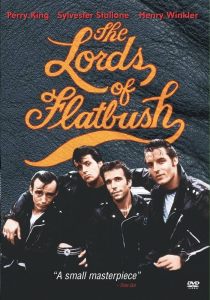 The year is 1958 and four Brooklyn teenagers, all members of a largely non-violent street gang called The Lords of Flatbush, have enough grease in their hair to start a city-wide kitchen fire. It’s their senior year of high school. Chico (Perry King) tries to hook up with a new, blonde transfer student (Susan Blakely). Butchey (Henry Winkler) makes everyone laugh and hides the fact that he’s secretly really smart. Stanley (Sylvester Stallone) deals with his impending marriage to Frannie (Maria Smith). Everyone has to grow up eventually but at least the Lords of Flatbush will always have their memories and probably their leather jackets.
The year is 1958 and four Brooklyn teenagers, all members of a largely non-violent street gang called The Lords of Flatbush, have enough grease in their hair to start a city-wide kitchen fire. It’s their senior year of high school. Chico (Perry King) tries to hook up with a new, blonde transfer student (Susan Blakely). Butchey (Henry Winkler) makes everyone laugh and hides the fact that he’s secretly really smart. Stanley (Sylvester Stallone) deals with his impending marriage to Frannie (Maria Smith). Everyone has to grow up eventually but at least the Lords of Flatbush will always have their memories and probably their leather jackets.
Nostalgia films that were extremely popular in the 70s, as the baby boomers were already starting to mythologize their youth. Lords of Flatbush is very much about that nostalgia, leading to a film that feels sincere but which is also pretty predictable. With its coming-of-age storylines and its mix of drama and comedy, Lords of Flatbush owes an obvious debt to American Graffiti. The movie, like its characters, is likable but not exactly memorable. Today, it’s really only known because it featured early performances from Sylvester Stallone and Henry Winkler. Winkler got his signature role as the Fonz on Happy Days largely based on his performance as Butchey, though Butchey is nowhere near as cool as the Fonz. Pre-Rocky, this movie was Stallone’s calling card in Hollywood and he rewrote enough of his own lines that he got an additional dialogue credit. Stallone actually gives a pretty good performance, even if he is obviously closer to 30 than 18.
Stallone’s best scene is when Stanley is trying to buy an engagement ring and Frannie insists that he buy one that costs $1,600. For the first time, Stanley realizes that getting married means committing to something other than hanging out with his friends and working on his car. Stanley buys the ring but threatens the jewelry store owner afterwards, telling him to never show Frannie a $1,600 ring again.
The Lords of Flatbush is a film about the past but it’s mostly interesting due to the future of its stars.



